Research: Factors Affecting Female Cabin Crew Retention in Singapore
VerifiedAdded on 2023/03/30
|66
|13342
|177
Thesis and Dissertation
AI Summary
This dissertation explores the factors influencing female cabin crew retention in Singapore Airlines. It begins by establishing the importance of female employees in the airline industry and highlights the problem of high turnover rates among female cabin crew in Singapore Airlines. The research aims to identify the determinants of job satisfaction, analyze the factors affecting retention, and investigate the impact of remuneration on retention rates. A comprehensive literature review supports the study, examining job satisfaction, remuneration, attitude, promotion, annual leave, working hours, and destination country as key factors. The methodology involves a quantitative approach, utilizing surveys to collect data, which is then analyzed to test the hypothesis that job satisfaction influences female cabin crew retention. The findings and conclusion provide insights into the relationship between these factors and employee retention within Singapore Airlines.
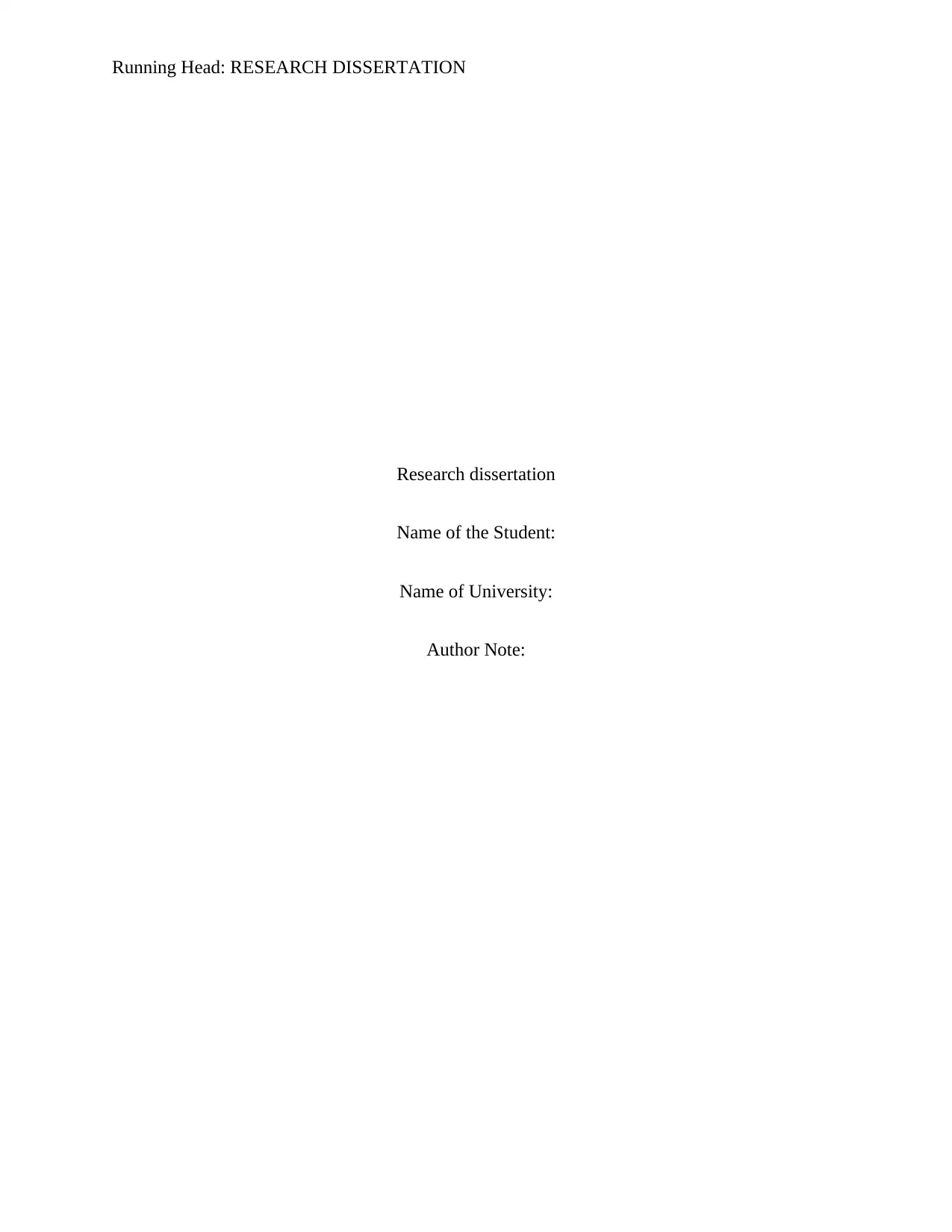
Running Head: RESEARCH DISSERTATION
Research dissertation
Name of the Student:
Name of University:
Author Note:
Research dissertation
Name of the Student:
Name of University:
Author Note:
Paraphrase This Document
Need a fresh take? Get an instant paraphrase of this document with our AI Paraphraser
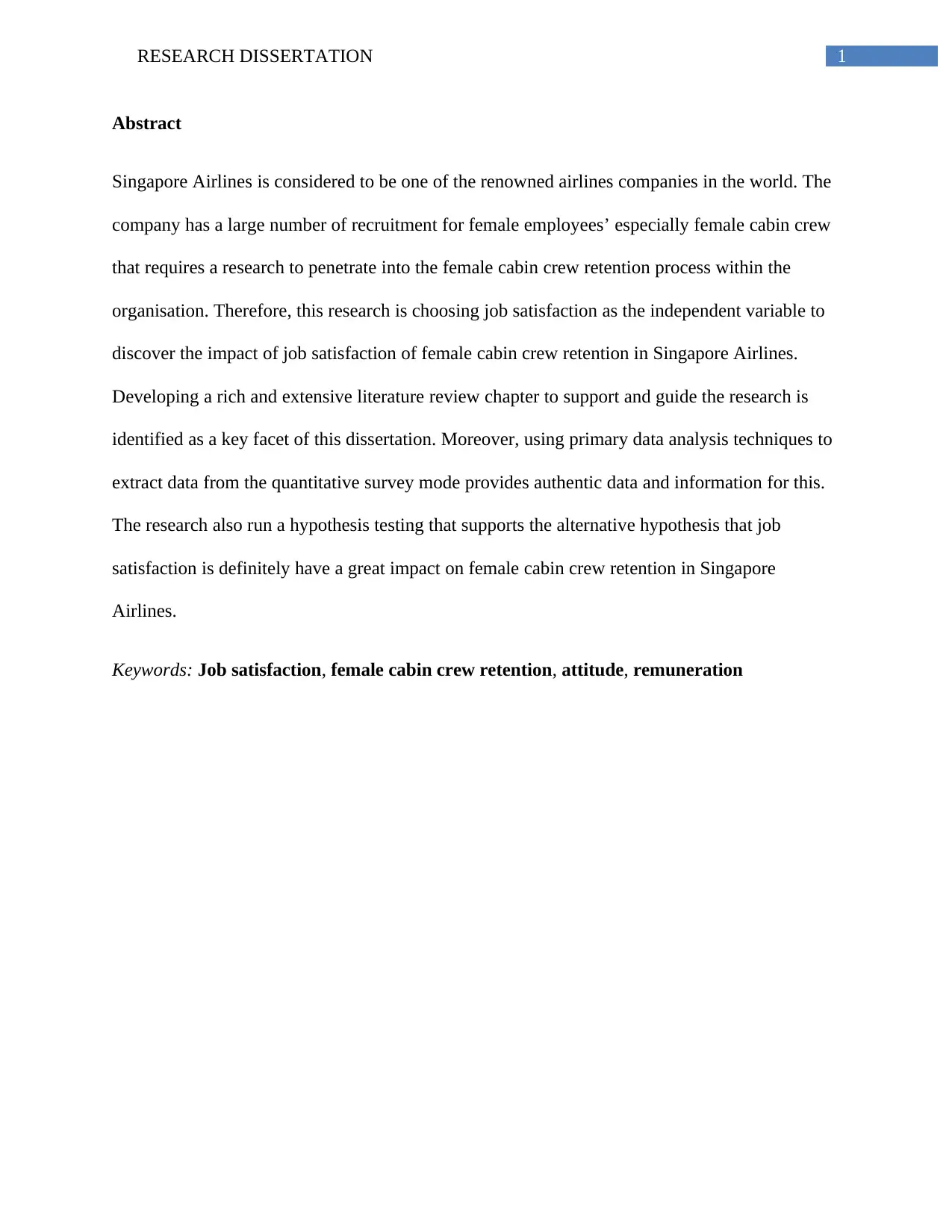
1RESEARCH DISSERTATION
Abstract
Singapore Airlines is considered to be one of the renowned airlines companies in the world. The
company has a large number of recruitment for female employees’ especially female cabin crew
that requires a research to penetrate into the female cabin crew retention process within the
organisation. Therefore, this research is choosing job satisfaction as the independent variable to
discover the impact of job satisfaction of female cabin crew retention in Singapore Airlines.
Developing a rich and extensive literature review chapter to support and guide the research is
identified as a key facet of this dissertation. Moreover, using primary data analysis techniques to
extract data from the quantitative survey mode provides authentic data and information for this.
The research also run a hypothesis testing that supports the alternative hypothesis that job
satisfaction is definitely have a great impact on female cabin crew retention in Singapore
Airlines.
Keywords: Job satisfaction, female cabin crew retention, attitude, remuneration
Abstract
Singapore Airlines is considered to be one of the renowned airlines companies in the world. The
company has a large number of recruitment for female employees’ especially female cabin crew
that requires a research to penetrate into the female cabin crew retention process within the
organisation. Therefore, this research is choosing job satisfaction as the independent variable to
discover the impact of job satisfaction of female cabin crew retention in Singapore Airlines.
Developing a rich and extensive literature review chapter to support and guide the research is
identified as a key facet of this dissertation. Moreover, using primary data analysis techniques to
extract data from the quantitative survey mode provides authentic data and information for this.
The research also run a hypothesis testing that supports the alternative hypothesis that job
satisfaction is definitely have a great impact on female cabin crew retention in Singapore
Airlines.
Keywords: Job satisfaction, female cabin crew retention, attitude, remuneration
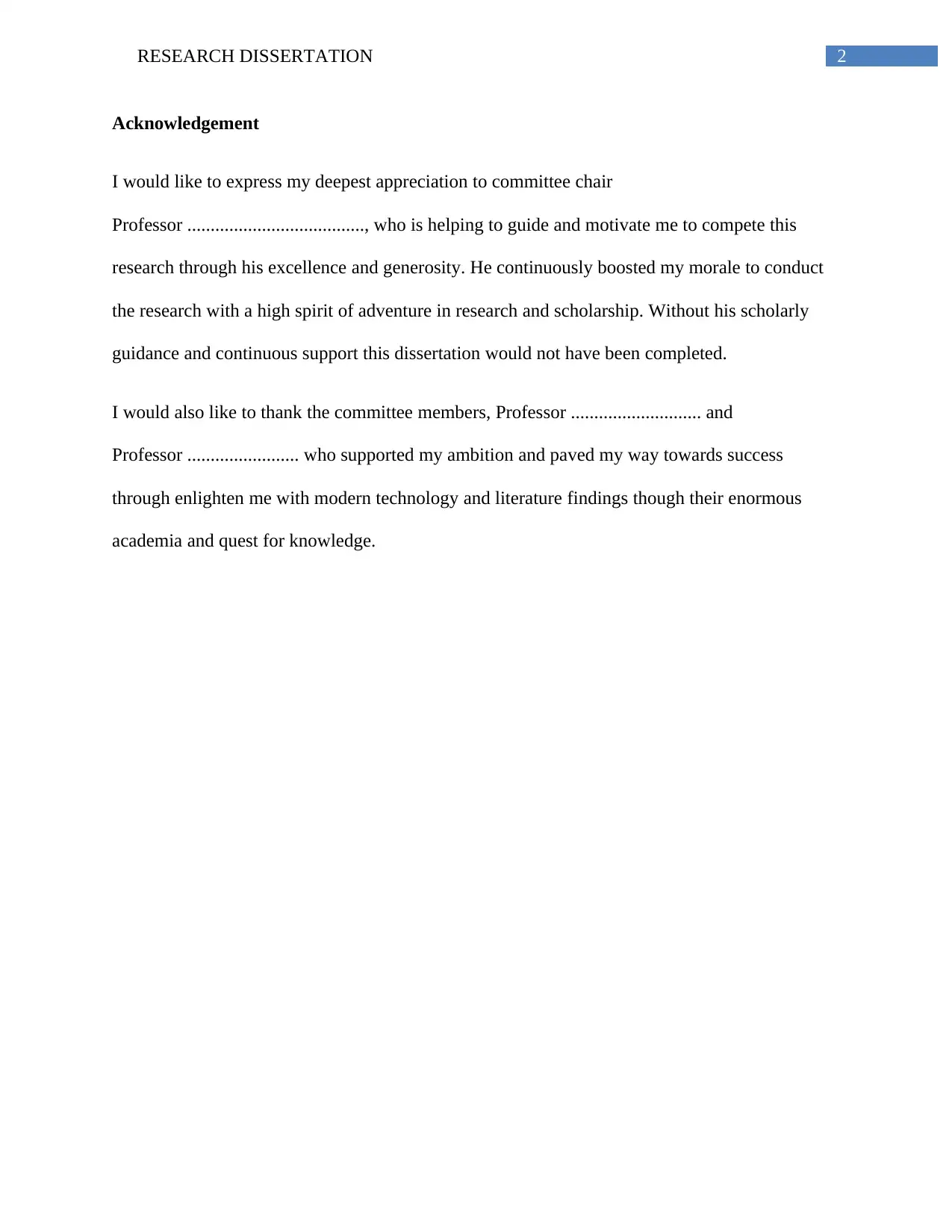
2RESEARCH DISSERTATION
Acknowledgement
I would like to express my deepest appreciation to committee chair
Professor ......................................, who is helping to guide and motivate me to compete this
research through his excellence and generosity. He continuously boosted my morale to conduct
the research with a high spirit of adventure in research and scholarship. Without his scholarly
guidance and continuous support this dissertation would not have been completed.
I would also like to thank the committee members, Professor ............................ and
Professor ........................ who supported my ambition and paved my way towards success
through enlighten me with modern technology and literature findings though their enormous
academia and quest for knowledge.
Acknowledgement
I would like to express my deepest appreciation to committee chair
Professor ......................................, who is helping to guide and motivate me to compete this
research through his excellence and generosity. He continuously boosted my morale to conduct
the research with a high spirit of adventure in research and scholarship. Without his scholarly
guidance and continuous support this dissertation would not have been completed.
I would also like to thank the committee members, Professor ............................ and
Professor ........................ who supported my ambition and paved my way towards success
through enlighten me with modern technology and literature findings though their enormous
academia and quest for knowledge.
⊘ This is a preview!⊘
Do you want full access?
Subscribe today to unlock all pages.

Trusted by 1+ million students worldwide
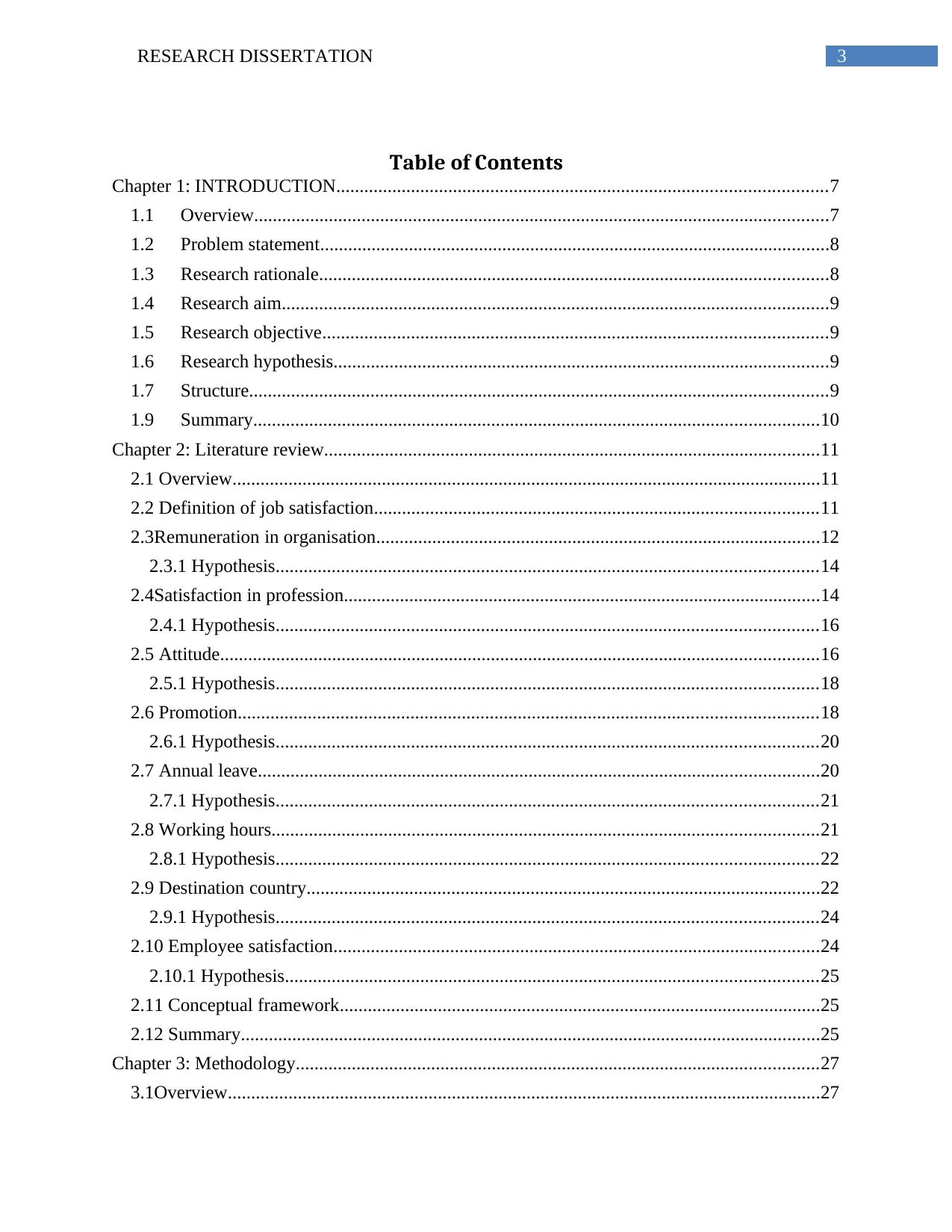
3RESEARCH DISSERTATION
Table of Contents
Chapter 1: INTRODUCTION.........................................................................................................7
1.1 Overview...........................................................................................................................7
1.2 Problem statement.............................................................................................................8
1.3 Research rationale.............................................................................................................8
1.4 Research aim.....................................................................................................................9
1.5 Research objective............................................................................................................9
1.6 Research hypothesis..........................................................................................................9
1.7 Structure............................................................................................................................9
1.9 Summary.........................................................................................................................10
Chapter 2: Literature review..........................................................................................................11
2.1 Overview..............................................................................................................................11
2.2 Definition of job satisfaction...............................................................................................11
2.3Remuneration in organisation...............................................................................................12
2.3.1 Hypothesis....................................................................................................................14
2.4Satisfaction in profession......................................................................................................14
2.4.1 Hypothesis....................................................................................................................16
2.5 Attitude................................................................................................................................16
2.5.1 Hypothesis....................................................................................................................18
2.6 Promotion............................................................................................................................18
2.6.1 Hypothesis....................................................................................................................20
2.7 Annual leave........................................................................................................................20
2.7.1 Hypothesis....................................................................................................................21
2.8 Working hours.....................................................................................................................21
2.8.1 Hypothesis....................................................................................................................22
2.9 Destination country..............................................................................................................22
2.9.1 Hypothesis....................................................................................................................24
2.10 Employee satisfaction........................................................................................................24
2.10.1 Hypothesis..................................................................................................................25
2.11 Conceptual framework.......................................................................................................25
2.12 Summary............................................................................................................................25
Chapter 3: Methodology................................................................................................................27
3.1Overview...............................................................................................................................27
Table of Contents
Chapter 1: INTRODUCTION.........................................................................................................7
1.1 Overview...........................................................................................................................7
1.2 Problem statement.............................................................................................................8
1.3 Research rationale.............................................................................................................8
1.4 Research aim.....................................................................................................................9
1.5 Research objective............................................................................................................9
1.6 Research hypothesis..........................................................................................................9
1.7 Structure............................................................................................................................9
1.9 Summary.........................................................................................................................10
Chapter 2: Literature review..........................................................................................................11
2.1 Overview..............................................................................................................................11
2.2 Definition of job satisfaction...............................................................................................11
2.3Remuneration in organisation...............................................................................................12
2.3.1 Hypothesis....................................................................................................................14
2.4Satisfaction in profession......................................................................................................14
2.4.1 Hypothesis....................................................................................................................16
2.5 Attitude................................................................................................................................16
2.5.1 Hypothesis....................................................................................................................18
2.6 Promotion............................................................................................................................18
2.6.1 Hypothesis....................................................................................................................20
2.7 Annual leave........................................................................................................................20
2.7.1 Hypothesis....................................................................................................................21
2.8 Working hours.....................................................................................................................21
2.8.1 Hypothesis....................................................................................................................22
2.9 Destination country..............................................................................................................22
2.9.1 Hypothesis....................................................................................................................24
2.10 Employee satisfaction........................................................................................................24
2.10.1 Hypothesis..................................................................................................................25
2.11 Conceptual framework.......................................................................................................25
2.12 Summary............................................................................................................................25
Chapter 3: Methodology................................................................................................................27
3.1Overview...............................................................................................................................27
Paraphrase This Document
Need a fresh take? Get an instant paraphrase of this document with our AI Paraphraser
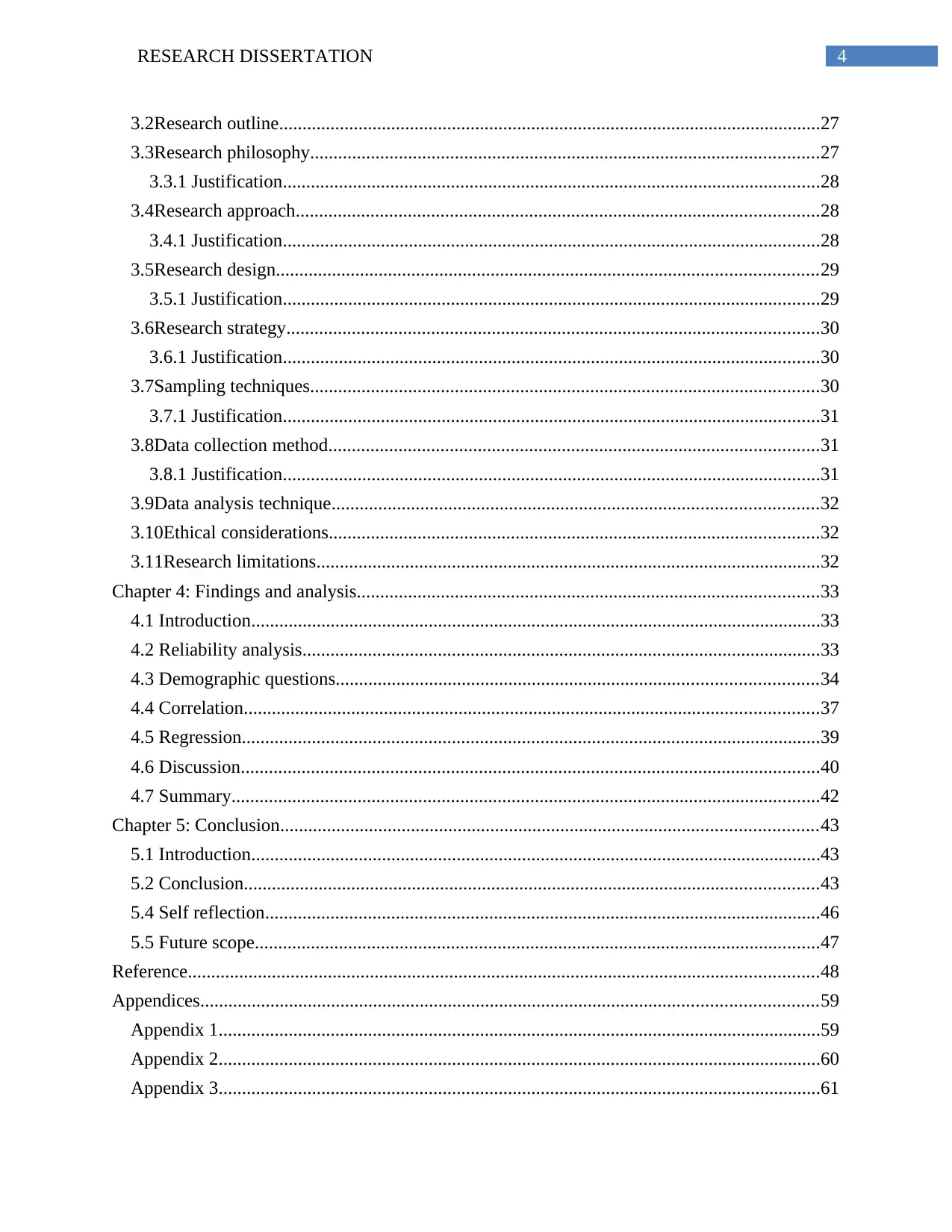
4RESEARCH DISSERTATION
3.2Research outline....................................................................................................................27
3.3Research philosophy.............................................................................................................27
3.3.1 Justification...................................................................................................................28
3.4Research approach................................................................................................................28
3.4.1 Justification...................................................................................................................28
3.5Research design....................................................................................................................29
3.5.1 Justification...................................................................................................................29
3.6Research strategy..................................................................................................................30
3.6.1 Justification...................................................................................................................30
3.7Sampling techniques.............................................................................................................30
3.7.1 Justification...................................................................................................................31
3.8Data collection method.........................................................................................................31
3.8.1 Justification...................................................................................................................31
3.9Data analysis technique........................................................................................................32
3.10Ethical considerations.........................................................................................................32
3.11Research limitations............................................................................................................32
Chapter 4: Findings and analysis...................................................................................................33
4.1 Introduction..........................................................................................................................33
4.2 Reliability analysis...............................................................................................................33
4.3 Demographic questions.......................................................................................................34
4.4 Correlation...........................................................................................................................37
4.5 Regression............................................................................................................................39
4.6 Discussion............................................................................................................................40
4.7 Summary..............................................................................................................................42
Chapter 5: Conclusion...................................................................................................................43
5.1 Introduction..........................................................................................................................43
5.2 Conclusion...........................................................................................................................43
5.4 Self reflection.......................................................................................................................46
5.5 Future scope.........................................................................................................................47
Reference.......................................................................................................................................48
Appendices....................................................................................................................................59
Appendix 1.................................................................................................................................59
Appendix 2.................................................................................................................................60
Appendix 3.................................................................................................................................61
3.2Research outline....................................................................................................................27
3.3Research philosophy.............................................................................................................27
3.3.1 Justification...................................................................................................................28
3.4Research approach................................................................................................................28
3.4.1 Justification...................................................................................................................28
3.5Research design....................................................................................................................29
3.5.1 Justification...................................................................................................................29
3.6Research strategy..................................................................................................................30
3.6.1 Justification...................................................................................................................30
3.7Sampling techniques.............................................................................................................30
3.7.1 Justification...................................................................................................................31
3.8Data collection method.........................................................................................................31
3.8.1 Justification...................................................................................................................31
3.9Data analysis technique........................................................................................................32
3.10Ethical considerations.........................................................................................................32
3.11Research limitations............................................................................................................32
Chapter 4: Findings and analysis...................................................................................................33
4.1 Introduction..........................................................................................................................33
4.2 Reliability analysis...............................................................................................................33
4.3 Demographic questions.......................................................................................................34
4.4 Correlation...........................................................................................................................37
4.5 Regression............................................................................................................................39
4.6 Discussion............................................................................................................................40
4.7 Summary..............................................................................................................................42
Chapter 5: Conclusion...................................................................................................................43
5.1 Introduction..........................................................................................................................43
5.2 Conclusion...........................................................................................................................43
5.4 Self reflection.......................................................................................................................46
5.5 Future scope.........................................................................................................................47
Reference.......................................................................................................................................48
Appendices....................................................................................................................................59
Appendix 1.................................................................................................................................59
Appendix 2.................................................................................................................................60
Appendix 3.................................................................................................................................61
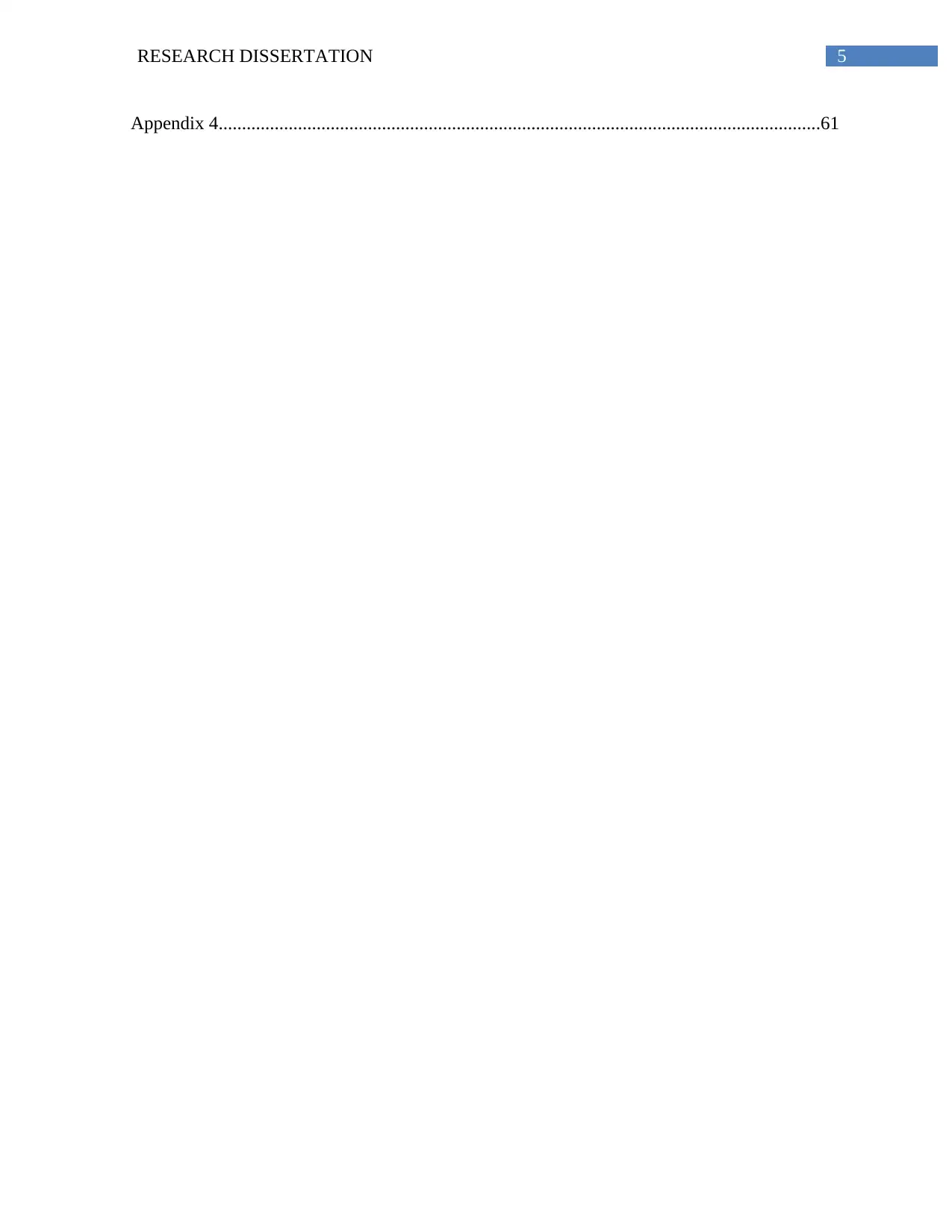
5RESEARCH DISSERTATION
Appendix 4.................................................................................................................................61
Appendix 4.................................................................................................................................61
⊘ This is a preview!⊘
Do you want full access?
Subscribe today to unlock all pages.

Trusted by 1+ million students worldwide
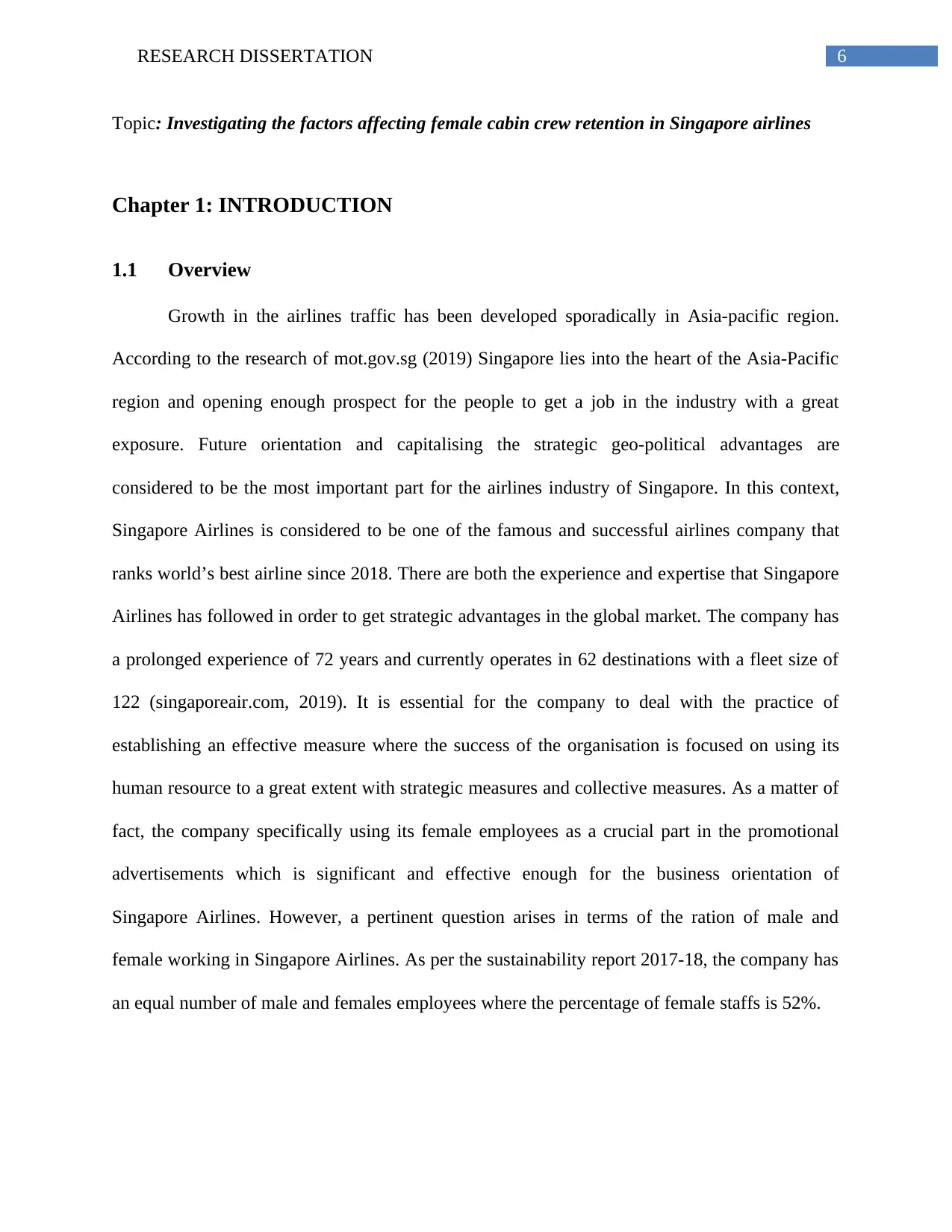
6RESEARCH DISSERTATION
Topic: Investigating the factors affecting female cabin crew retention in Singapore airlines
Chapter 1: INTRODUCTION
1.1 Overview
Growth in the airlines traffic has been developed sporadically in Asia-pacific region.
According to the research of mot.gov.sg (2019) Singapore lies into the heart of the Asia-Pacific
region and opening enough prospect for the people to get a job in the industry with a great
exposure. Future orientation and capitalising the strategic geo-political advantages are
considered to be the most important part for the airlines industry of Singapore. In this context,
Singapore Airlines is considered to be one of the famous and successful airlines company that
ranks world’s best airline since 2018. There are both the experience and expertise that Singapore
Airlines has followed in order to get strategic advantages in the global market. The company has
a prolonged experience of 72 years and currently operates in 62 destinations with a fleet size of
122 (singaporeair.com, 2019). It is essential for the company to deal with the practice of
establishing an effective measure where the success of the organisation is focused on using its
human resource to a great extent with strategic measures and collective measures. As a matter of
fact, the company specifically using its female employees as a crucial part in the promotional
advertisements which is significant and effective enough for the business orientation of
Singapore Airlines. However, a pertinent question arises in terms of the ration of male and
female working in Singapore Airlines. As per the sustainability report 2017-18, the company has
an equal number of male and females employees where the percentage of female staffs is 52%.
Topic: Investigating the factors affecting female cabin crew retention in Singapore airlines
Chapter 1: INTRODUCTION
1.1 Overview
Growth in the airlines traffic has been developed sporadically in Asia-pacific region.
According to the research of mot.gov.sg (2019) Singapore lies into the heart of the Asia-Pacific
region and opening enough prospect for the people to get a job in the industry with a great
exposure. Future orientation and capitalising the strategic geo-political advantages are
considered to be the most important part for the airlines industry of Singapore. In this context,
Singapore Airlines is considered to be one of the famous and successful airlines company that
ranks world’s best airline since 2018. There are both the experience and expertise that Singapore
Airlines has followed in order to get strategic advantages in the global market. The company has
a prolonged experience of 72 years and currently operates in 62 destinations with a fleet size of
122 (singaporeair.com, 2019). It is essential for the company to deal with the practice of
establishing an effective measure where the success of the organisation is focused on using its
human resource to a great extent with strategic measures and collective measures. As a matter of
fact, the company specifically using its female employees as a crucial part in the promotional
advertisements which is significant and effective enough for the business orientation of
Singapore Airlines. However, a pertinent question arises in terms of the ration of male and
female working in Singapore Airlines. As per the sustainability report 2017-18, the company has
an equal number of male and females employees where the percentage of female staffs is 52%.
Paraphrase This Document
Need a fresh take? Get an instant paraphrase of this document with our AI Paraphraser
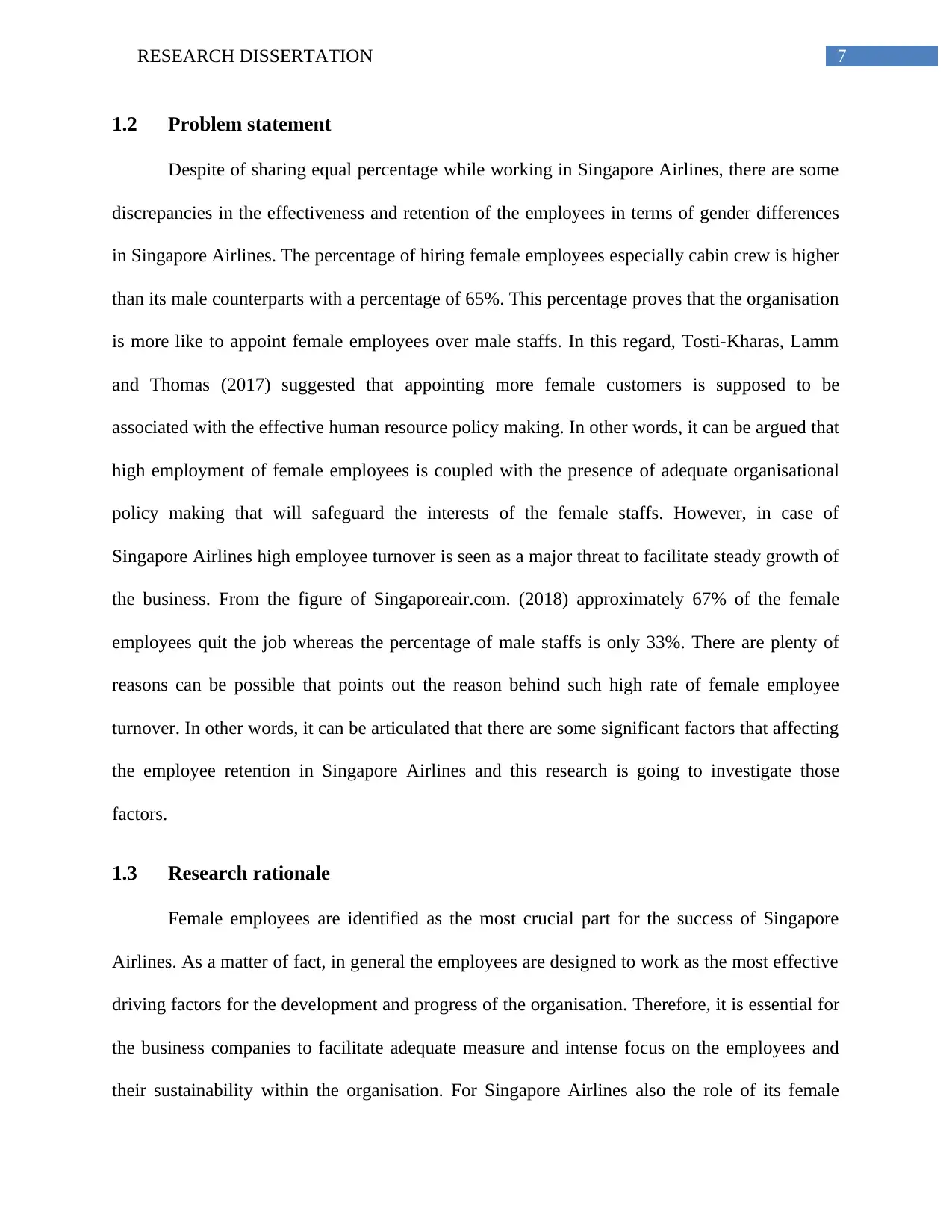
7RESEARCH DISSERTATION
1.2 Problem statement
Despite of sharing equal percentage while working in Singapore Airlines, there are some
discrepancies in the effectiveness and retention of the employees in terms of gender differences
in Singapore Airlines. The percentage of hiring female employees especially cabin crew is higher
than its male counterparts with a percentage of 65%. This percentage proves that the organisation
is more like to appoint female employees over male staffs. In this regard, Tosti-Kharas, Lamm
and Thomas (2017) suggested that appointing more female customers is supposed to be
associated with the effective human resource policy making. In other words, it can be argued that
high employment of female employees is coupled with the presence of adequate organisational
policy making that will safeguard the interests of the female staffs. However, in case of
Singapore Airlines high employee turnover is seen as a major threat to facilitate steady growth of
the business. From the figure of Singaporeair.com. (2018) approximately 67% of the female
employees quit the job whereas the percentage of male staffs is only 33%. There are plenty of
reasons can be possible that points out the reason behind such high rate of female employee
turnover. In other words, it can be articulated that there are some significant factors that affecting
the employee retention in Singapore Airlines and this research is going to investigate those
factors.
1.3 Research rationale
Female employees are identified as the most crucial part for the success of Singapore
Airlines. As a matter of fact, in general the employees are designed to work as the most effective
driving factors for the development and progress of the organisation. Therefore, it is essential for
the business companies to facilitate adequate measure and intense focus on the employees and
their sustainability within the organisation. For Singapore Airlines also the role of its female
1.2 Problem statement
Despite of sharing equal percentage while working in Singapore Airlines, there are some
discrepancies in the effectiveness and retention of the employees in terms of gender differences
in Singapore Airlines. The percentage of hiring female employees especially cabin crew is higher
than its male counterparts with a percentage of 65%. This percentage proves that the organisation
is more like to appoint female employees over male staffs. In this regard, Tosti-Kharas, Lamm
and Thomas (2017) suggested that appointing more female customers is supposed to be
associated with the effective human resource policy making. In other words, it can be argued that
high employment of female employees is coupled with the presence of adequate organisational
policy making that will safeguard the interests of the female staffs. However, in case of
Singapore Airlines high employee turnover is seen as a major threat to facilitate steady growth of
the business. From the figure of Singaporeair.com. (2018) approximately 67% of the female
employees quit the job whereas the percentage of male staffs is only 33%. There are plenty of
reasons can be possible that points out the reason behind such high rate of female employee
turnover. In other words, it can be articulated that there are some significant factors that affecting
the employee retention in Singapore Airlines and this research is going to investigate those
factors.
1.3 Research rationale
Female employees are identified as the most crucial part for the success of Singapore
Airlines. As a matter of fact, in general the employees are designed to work as the most effective
driving factors for the development and progress of the organisation. Therefore, it is essential for
the business companies to facilitate adequate measure and intense focus on the employees and
their sustainability within the organisation. For Singapore Airlines also the role of its female
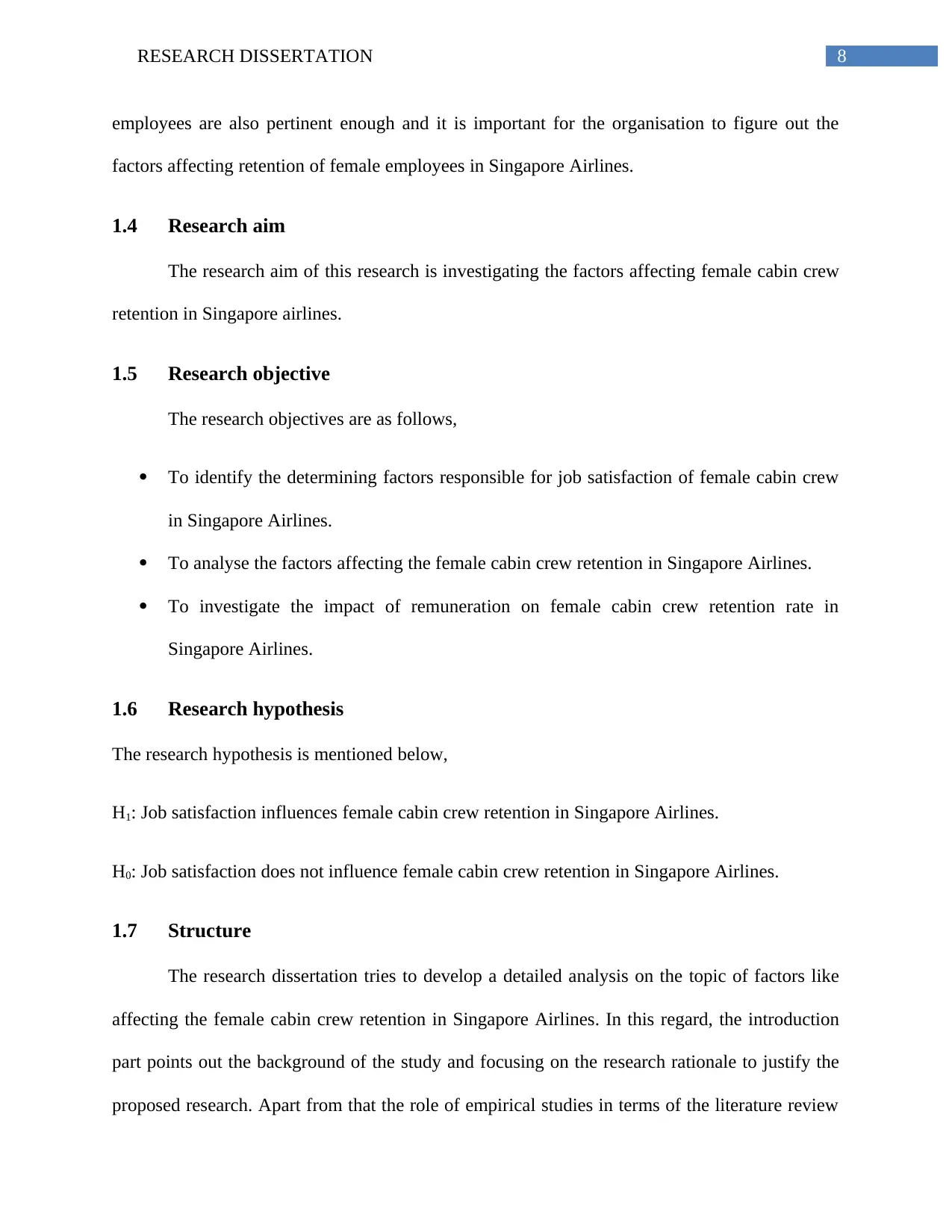
8RESEARCH DISSERTATION
employees are also pertinent enough and it is important for the organisation to figure out the
factors affecting retention of female employees in Singapore Airlines.
1.4 Research aim
The research aim of this research is investigating the factors affecting female cabin crew
retention in Singapore airlines.
1.5 Research objective
The research objectives are as follows,
To identify the determining factors responsible for job satisfaction of female cabin crew
in Singapore Airlines.
To analyse the factors affecting the female cabin crew retention in Singapore Airlines.
To investigate the impact of remuneration on female cabin crew retention rate in
Singapore Airlines.
1.6 Research hypothesis
The research hypothesis is mentioned below,
H1: Job satisfaction influences female cabin crew retention in Singapore Airlines.
H0: Job satisfaction does not influence female cabin crew retention in Singapore Airlines.
1.7 Structure
The research dissertation tries to develop a detailed analysis on the topic of factors like
affecting the female cabin crew retention in Singapore Airlines. In this regard, the introduction
part points out the background of the study and focusing on the research rationale to justify the
proposed research. Apart from that the role of empirical studies in terms of the literature review
employees are also pertinent enough and it is important for the organisation to figure out the
factors affecting retention of female employees in Singapore Airlines.
1.4 Research aim
The research aim of this research is investigating the factors affecting female cabin crew
retention in Singapore airlines.
1.5 Research objective
The research objectives are as follows,
To identify the determining factors responsible for job satisfaction of female cabin crew
in Singapore Airlines.
To analyse the factors affecting the female cabin crew retention in Singapore Airlines.
To investigate the impact of remuneration on female cabin crew retention rate in
Singapore Airlines.
1.6 Research hypothesis
The research hypothesis is mentioned below,
H1: Job satisfaction influences female cabin crew retention in Singapore Airlines.
H0: Job satisfaction does not influence female cabin crew retention in Singapore Airlines.
1.7 Structure
The research dissertation tries to develop a detailed analysis on the topic of factors like
affecting the female cabin crew retention in Singapore Airlines. In this regard, the introduction
part points out the background of the study and focusing on the research rationale to justify the
proposed research. Apart from that the role of empirical studies in terms of the literature review
⊘ This is a preview!⊘
Do you want full access?
Subscribe today to unlock all pages.

Trusted by 1+ million students worldwide
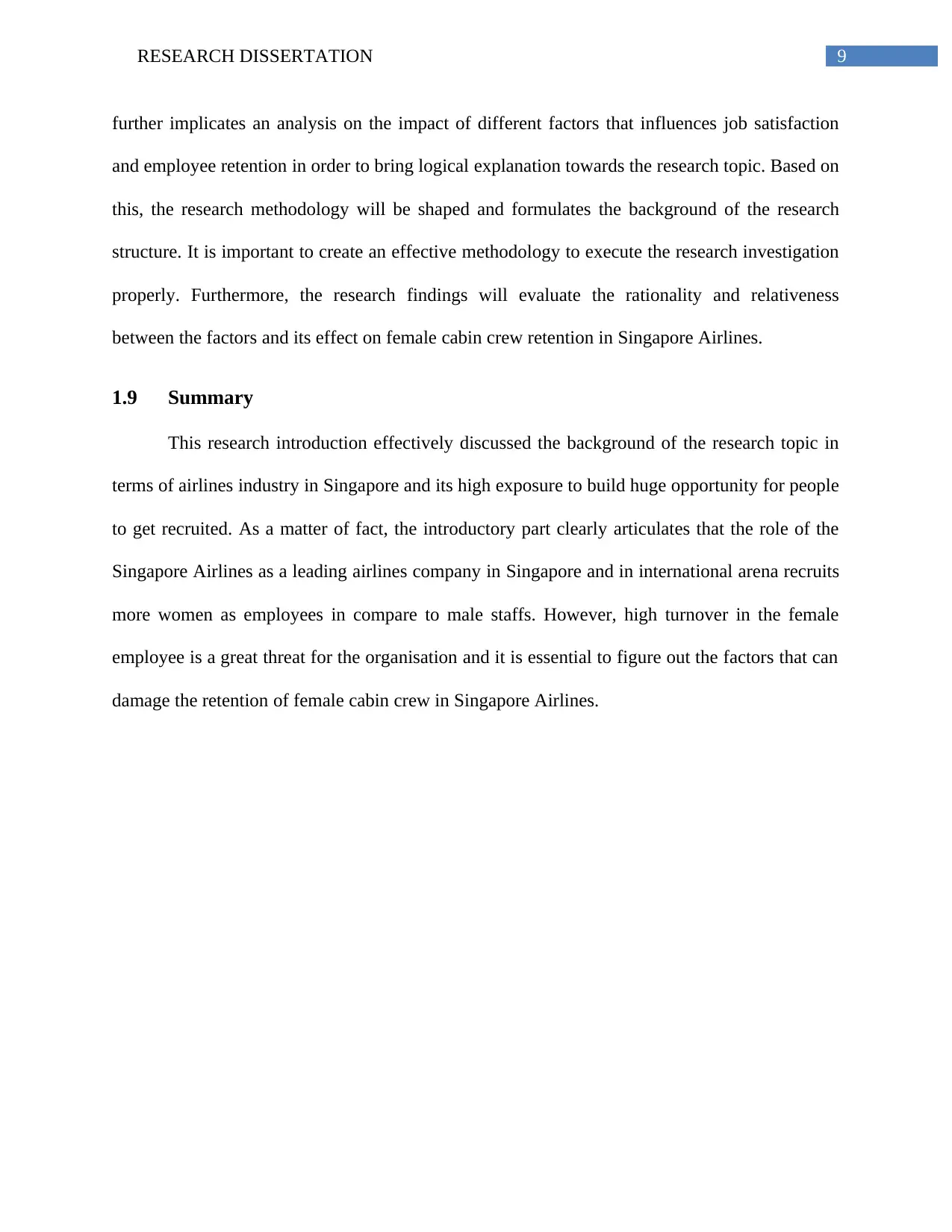
9RESEARCH DISSERTATION
further implicates an analysis on the impact of different factors that influences job satisfaction
and employee retention in order to bring logical explanation towards the research topic. Based on
this, the research methodology will be shaped and formulates the background of the research
structure. It is important to create an effective methodology to execute the research investigation
properly. Furthermore, the research findings will evaluate the rationality and relativeness
between the factors and its effect on female cabin crew retention in Singapore Airlines.
1.9 Summary
This research introduction effectively discussed the background of the research topic in
terms of airlines industry in Singapore and its high exposure to build huge opportunity for people
to get recruited. As a matter of fact, the introductory part clearly articulates that the role of the
Singapore Airlines as a leading airlines company in Singapore and in international arena recruits
more women as employees in compare to male staffs. However, high turnover in the female
employee is a great threat for the organisation and it is essential to figure out the factors that can
damage the retention of female cabin crew in Singapore Airlines.
further implicates an analysis on the impact of different factors that influences job satisfaction
and employee retention in order to bring logical explanation towards the research topic. Based on
this, the research methodology will be shaped and formulates the background of the research
structure. It is important to create an effective methodology to execute the research investigation
properly. Furthermore, the research findings will evaluate the rationality and relativeness
between the factors and its effect on female cabin crew retention in Singapore Airlines.
1.9 Summary
This research introduction effectively discussed the background of the research topic in
terms of airlines industry in Singapore and its high exposure to build huge opportunity for people
to get recruited. As a matter of fact, the introductory part clearly articulates that the role of the
Singapore Airlines as a leading airlines company in Singapore and in international arena recruits
more women as employees in compare to male staffs. However, high turnover in the female
employee is a great threat for the organisation and it is essential to figure out the factors that can
damage the retention of female cabin crew in Singapore Airlines.
Paraphrase This Document
Need a fresh take? Get an instant paraphrase of this document with our AI Paraphraser
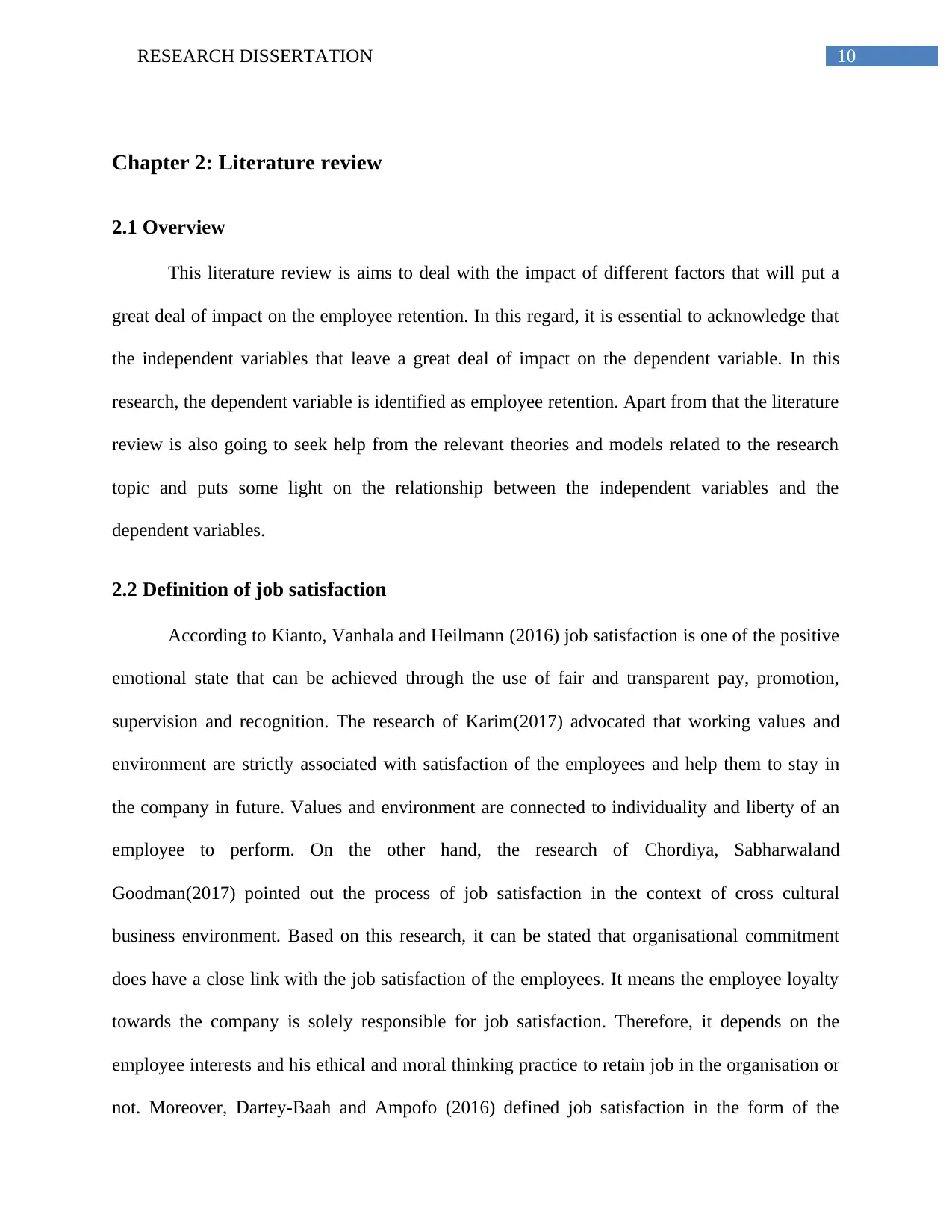
10RESEARCH DISSERTATION
Chapter 2: Literature review
2.1 Overview
This literature review is aims to deal with the impact of different factors that will put a
great deal of impact on the employee retention. In this regard, it is essential to acknowledge that
the independent variables that leave a great deal of impact on the dependent variable. In this
research, the dependent variable is identified as employee retention. Apart from that the literature
review is also going to seek help from the relevant theories and models related to the research
topic and puts some light on the relationship between the independent variables and the
dependent variables.
2.2 Definition of job satisfaction
According to Kianto, Vanhala and Heilmann (2016) job satisfaction is one of the positive
emotional state that can be achieved through the use of fair and transparent pay, promotion,
supervision and recognition. The research of Karim(2017) advocated that working values and
environment are strictly associated with satisfaction of the employees and help them to stay in
the company in future. Values and environment are connected to individuality and liberty of an
employee to perform. On the other hand, the research of Chordiya, Sabharwaland
Goodman(2017) pointed out the process of job satisfaction in the context of cross cultural
business environment. Based on this research, it can be stated that organisational commitment
does have a close link with the job satisfaction of the employees. It means the employee loyalty
towards the company is solely responsible for job satisfaction. Therefore, it depends on the
employee interests and his ethical and moral thinking practice to retain job in the organisation or
not. Moreover, Dartey-Baah and Ampofo (2016) defined job satisfaction in the form of the
Chapter 2: Literature review
2.1 Overview
This literature review is aims to deal with the impact of different factors that will put a
great deal of impact on the employee retention. In this regard, it is essential to acknowledge that
the independent variables that leave a great deal of impact on the dependent variable. In this
research, the dependent variable is identified as employee retention. Apart from that the literature
review is also going to seek help from the relevant theories and models related to the research
topic and puts some light on the relationship between the independent variables and the
dependent variables.
2.2 Definition of job satisfaction
According to Kianto, Vanhala and Heilmann (2016) job satisfaction is one of the positive
emotional state that can be achieved through the use of fair and transparent pay, promotion,
supervision and recognition. The research of Karim(2017) advocated that working values and
environment are strictly associated with satisfaction of the employees and help them to stay in
the company in future. Values and environment are connected to individuality and liberty of an
employee to perform. On the other hand, the research of Chordiya, Sabharwaland
Goodman(2017) pointed out the process of job satisfaction in the context of cross cultural
business environment. Based on this research, it can be stated that organisational commitment
does have a close link with the job satisfaction of the employees. It means the employee loyalty
towards the company is solely responsible for job satisfaction. Therefore, it depends on the
employee interests and his ethical and moral thinking practice to retain job in the organisation or
not. Moreover, Dartey-Baah and Ampofo (2016) defined job satisfaction in the form of the
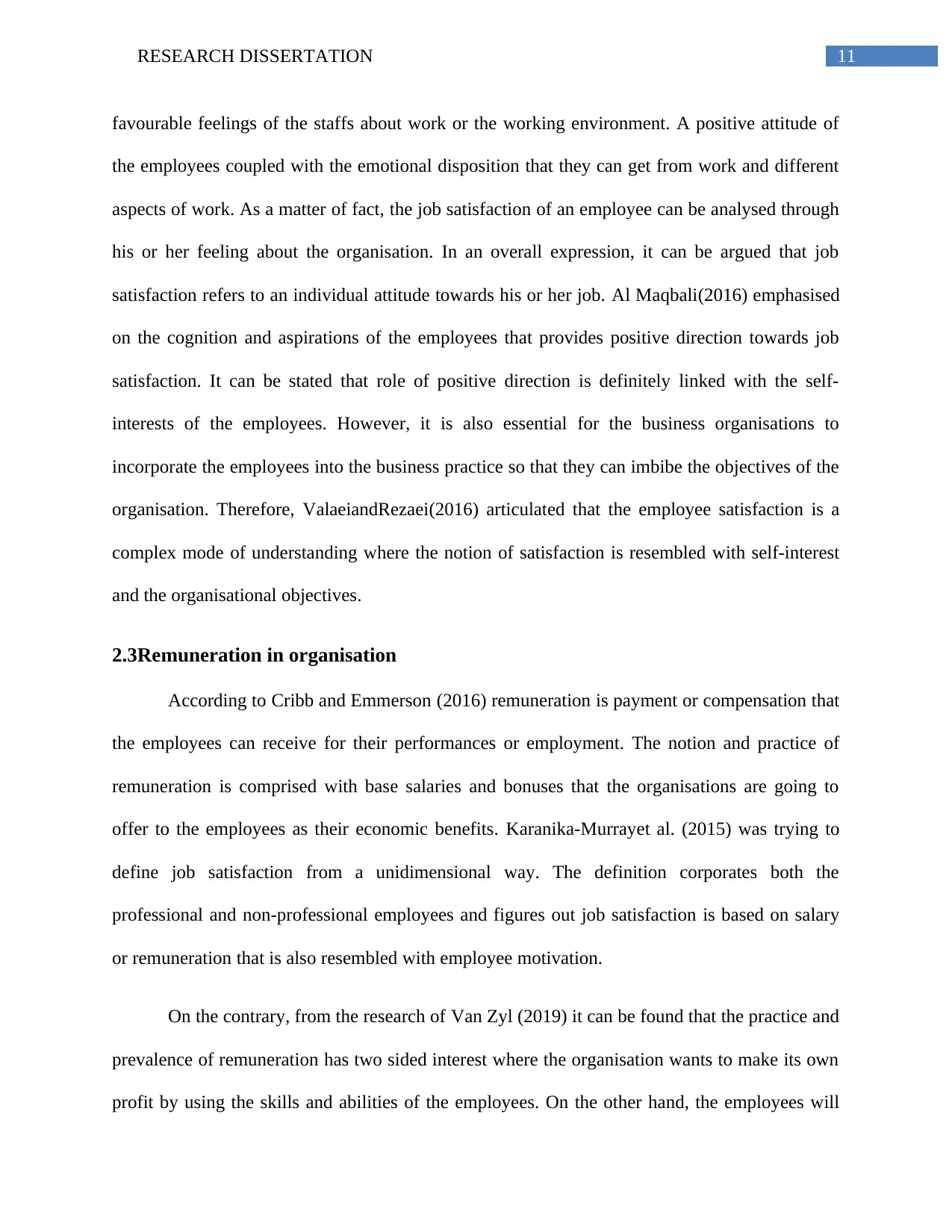
11RESEARCH DISSERTATION
favourable feelings of the staffs about work or the working environment. A positive attitude of
the employees coupled with the emotional disposition that they can get from work and different
aspects of work. As a matter of fact, the job satisfaction of an employee can be analysed through
his or her feeling about the organisation. In an overall expression, it can be argued that job
satisfaction refers to an individual attitude towards his or her job. Al Maqbali(2016) emphasised
on the cognition and aspirations of the employees that provides positive direction towards job
satisfaction. It can be stated that role of positive direction is definitely linked with the self-
interests of the employees. However, it is also essential for the business organisations to
incorporate the employees into the business practice so that they can imbibe the objectives of the
organisation. Therefore, ValaeiandRezaei(2016) articulated that the employee satisfaction is a
complex mode of understanding where the notion of satisfaction is resembled with self-interest
and the organisational objectives.
2.3Remuneration in organisation
According to Cribb and Emmerson (2016) remuneration is payment or compensation that
the employees can receive for their performances or employment. The notion and practice of
remuneration is comprised with base salaries and bonuses that the organisations are going to
offer to the employees as their economic benefits. Karanika-Murrayet al. (2015) was trying to
define job satisfaction from a unidimensional way. The definition corporates both the
professional and non-professional employees and figures out job satisfaction is based on salary
or remuneration that is also resembled with employee motivation.
On the contrary, from the research of Van Zyl (2019) it can be found that the practice and
prevalence of remuneration has two sided interest where the organisation wants to make its own
profit by using the skills and abilities of the employees. On the other hand, the employees will
favourable feelings of the staffs about work or the working environment. A positive attitude of
the employees coupled with the emotional disposition that they can get from work and different
aspects of work. As a matter of fact, the job satisfaction of an employee can be analysed through
his or her feeling about the organisation. In an overall expression, it can be argued that job
satisfaction refers to an individual attitude towards his or her job. Al Maqbali(2016) emphasised
on the cognition and aspirations of the employees that provides positive direction towards job
satisfaction. It can be stated that role of positive direction is definitely linked with the self-
interests of the employees. However, it is also essential for the business organisations to
incorporate the employees into the business practice so that they can imbibe the objectives of the
organisation. Therefore, ValaeiandRezaei(2016) articulated that the employee satisfaction is a
complex mode of understanding where the notion of satisfaction is resembled with self-interest
and the organisational objectives.
2.3Remuneration in organisation
According to Cribb and Emmerson (2016) remuneration is payment or compensation that
the employees can receive for their performances or employment. The notion and practice of
remuneration is comprised with base salaries and bonuses that the organisations are going to
offer to the employees as their economic benefits. Karanika-Murrayet al. (2015) was trying to
define job satisfaction from a unidimensional way. The definition corporates both the
professional and non-professional employees and figures out job satisfaction is based on salary
or remuneration that is also resembled with employee motivation.
On the contrary, from the research of Van Zyl (2019) it can be found that the practice and
prevalence of remuneration has two sided interest where the organisation wants to make its own
profit by using the skills and abilities of the employees. On the other hand, the employees will
⊘ This is a preview!⊘
Do you want full access?
Subscribe today to unlock all pages.

Trusted by 1+ million students worldwide
1 out of 66
Related Documents
Your All-in-One AI-Powered Toolkit for Academic Success.
+13062052269
info@desklib.com
Available 24*7 on WhatsApp / Email
![[object Object]](/_next/static/media/star-bottom.7253800d.svg)
Unlock your academic potential
Copyright © 2020–2025 A2Z Services. All Rights Reserved. Developed and managed by ZUCOL.





